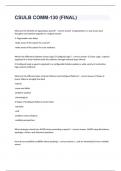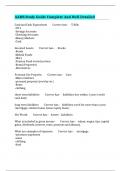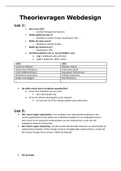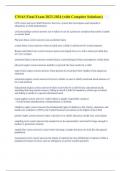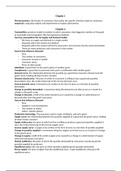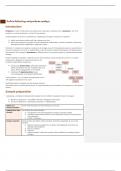Chapter 1: A framework for business analysis and valuation using financial statements
Capital market = Markets where entrepreneurs raise funds to finance their business ideas in
exchange for equity or debt securities.
- Play an important role in channelling financial resources from savers to business
enterprises that need capital.
- Financial statement analysis is a valuable activity when managers have complete
information on a firm’s strategies, and a variety of institutional factors make it
unlikely that they fully disclose this information to suppliers of capital.
To understand the contribution that financial statement analysis can make, it is important to
understand the role of financial reporting in the functioning of capital markets and the
institutional forces that shape financial statements.
The role of financial reporting in capital markets
The allocation of savings to investment opportunities is a critical challenge for any economy.
- When done well, economies can exploit new business ideas to spur innovation and
create jobs and wealth at rapid pace.
- When done poorly, economies waste their wealth and fail to support business
opportunities.
In capital markets, there are usually many new entrepreneurs and existing companies that
would like to attract savings to fund their business ideas.
- But, matching savings to business investment opportunities through the use of
capital markets is complicated for at least 3 reasons:
1) Information asymmetry between savers and entrepreneurs: Entrepreneurs typically
have better information than savers on the value of business investment
opportunities.
2) Potentially conflicting interests – credibility problems: Communication by
entrepreneurs to savers is not completely credible because savers don’t know that
entrepreneurs have an incentive to inflate the value of their ideas.
3) Expertise asymmetry: Savers generally lack the financial sophistication needed to
analyse and differentiate between various business opportunities.
Information and incentive issues lead to “the lemons problem”.
- Lemons problem = the problem that arises if entrepreneurs have better information
about the quality of their business ideas than investors but are not able to credibly
communicate this information. If this problem becomes severe enough, investors
may no longer be willing to provide funds and capital markets could break down.
- E.g., we have a situation where 50% of business ideas are “good” and the other 50%
are “bad”. If investors cannot distinguish between the two types of business ideas,
entrepreneurs with “bad” ideas will try to claim that their ideas are as valuable as the
“good” ideas
, Investors value both good and bad ideas at an average level entrepreneurs
with “good ideas” leave the capital market, since they find the terms on which they
can get financing unattractive the proportion of bad ideas in the market increases.
Market intermediaries can prevent such a market breakdown by resolving problems of
information asymmetry between managers and investors. There are 2 types:
- Financial intermediaries = specialise in collecting, aggregating, and investing funds
from dispersed investors (banks and collective investment funds).
- Information intermediaries = improve the (credibility of) information provided by
the manager (auditors or financial analysts).
- Both add value by helping investors distinguish between “good” and “bad”
investment opportunities.
Many countries in Europe have recently shifted to a model of strong legal protection of
investors’ rights = laws and regulations aiming at providing investors the rights and
mechanisms to discipline managers who control their funds.
- Examples: transparent disclosure requirements, the right to vote on important
decisions or the right to appoint supervisory directors.
- Financial reporting plays a critical role in the functioning of both the information
intermediaries and the financial intermediaries.
In the next sector, key aspects of the financial reporting system design are
discussed that enable it to play effectively this vital role in the functioning of the
capital markets.
From business activities to financial statements
A firm’s financial statements summarise the economic consequences of its business
activities.
- Periodically disclosed set of statements showing a company’s financial performance
and change in financial position during a prespecified period.
- The statements typically include: balance sheet (showing financial position);
comprehensive income statement and a cash flow statement (showing financial
performance); a statement of changes in equity (showing equity effects of
comprehensive income and transactions with the owners of the firm); and a
statement of other comprehensive income (shows the source of changes
- Primary purpose = inform current or potential investors about management’s use of
their funds, such that they can evaluate management’s actions and value their
current or potential claim on the firm.
Influences of the accounting system on information quality
- Financial reports are influenced both by the firm’s business activities and its
accounting system.
- Key aspect of financial statement analysis: understanding the influence of the
accounting system on the quality of financial statement data being used in the
analysis.
- Institutional features of accounting systems (discussed next) determine the extent of
that influence:
,Feature 1: accrual accounting
Accrual accounting = a system of accounting under which current profit or loss is derived
from past and current as well as expected future cash flows arising from business
transactions completed in the current period.
- To compute profit or loss, the effects of economic transactions are recorded based
on expected, not necessarily actual, cash receipts and payments.
- Expected cash inflows are recognised as revenues, and expected cash outflows are
recognised as expenses.
Only a few conceptual building blocks form the foundation of accrual accounting:
From the balance sheet:
- Assets = economic resources controlled by a firm that (a) have the potential to
produce future economic benefits and (b) are measurable with a reasonable degree
of certainty (e.g., inventories that will produce economic benefits once sold)
- Liabilities = economic obligations of a firm that (a) arise from benefits received in the
past, (b) have the potential of being required to be met, and (c) cannot be feasibly
avoided by the firm (e.g., bank loans that must be settled in cash).
- Equity = the difference between a firm’s assets and its liabilities.
Balance sheet relationship: Assets = Liabilities + Equity
Definitions critical to the (comprehensive) income statement, which summarises firms’
incomes and expenses:
- Income or revenue = economic resources earned (or increases in assets that affect
equity) and performance obligations settled (or decreases in liabilities that affect
equity) during a time period.
Revenues should be recognised when (a) the firm has provided all, or
substantially all, the goods or services to be delivered to the customer, and (b)
the customer has paid cash or is expected to pay cash with a reasonable degree
of certainty.
- Expenses = economic resources used up (or decreases in assets that affect equity)
and economic obligations created (or increases in liabilities that affect equity) during
a time period.
- Profit or loss = the difference between a firm’s income and expenses.
income statement relationship: Profit/loss = income – expenses.
Feature 2: Accounting conventions and standards
A number of accounting conventions have been implemented to ensure that managers use
their accounting flexibility to summarise their knowledge of the firm’s business activities,
and not to disguise reality for self-serving purposes.
- Because investors view profits as a measure of managers’ performance managers
have incentives to use their accounting discretion to distort reported profits by
making biased assumptions.
, Accounting standards = set of rules governing the determination of a company’s revenues,
profits, and (change in) financial position under a system of accrual accounting.
- Disclosure principles guide the amount and kinds of information that are disclosed
and require the firm to provide qualitative information related to assumptions,
policies, and uncertainties that underlie the quantitative data presented.
- Uniform accounting standards improve comparability of financial statements and
increase the credibility of financial statements by limiting a firm’s ability to distort
them.
- Examples:
EU companies must prepare their consolidated financial statements in accordance
with International Financial Reporting Standards (IFRS)
UK-based public companies must continue to prepare IFRS-based consolidated
financial statements, even after the UK’s Brexit.
Feature 3: Managers’ reporting strategy
Reporting strategy = the manner in which managers use their accounting discretion, shaping
the quality of their financial reports.
- Managers can choose accounting and disclosure policies that make it more or less
difficult for external users of financial reports to understand the true economic
picture of their businesses.
- A superior disclosure strategy will enable managers to communicate the underlying
business reality to outside investors.
- Managers can also use financial reporting strategies to manipulate investors’
perceptions, by for instance making it difficult for investors to identify poor
performance.
Feature 4: Auditing, Legal Liability, and Public enforcement
A) Auditing = certification of financial statements by an independent public accounting
firm, aimed at improving the statements’ credibility. I.e., a verification of the integrity
of the reported financial statements by someone other than the preparer.
- Ensures that managers use accounting rules and conventions consistently over time
and that their accounting estimates are reasonable.
- However, primary responsibility for the statements still rests with corporate
managers.
In the EU, audits must be carried out in accordance with the International Standards
on Auditing (ISA).
In the US, independent auditors must follow Generally Accepted Auditing Standards,
which are standards comparable to the ISA.
B) Legal liability: the legal environment in which accounting disputes between
managers, auditors, and investors are adjudicated can also have a significant effect
on the quality of reported numbers.
- Legal liability regimes vary in strictness across countries.
Under strict regimes, investors can hold managers liable for their investment losses if
the investors prove that the firm’s disclosures were misleading.
Under less strict regimes, investors must additionally prove that managers were
negligent in their reporting or even had the intent to harm investors.



